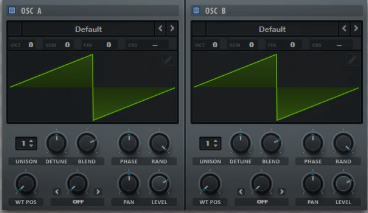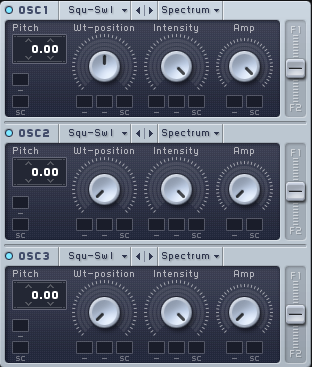Alright, welcome back to Synth Secrets! In Part 1, we got our heads around the basic idea of synthesis – making sound electronically from scratch. In Part 2, we took a fun trip through history, seeing how these amazing machines evolved from massive contraptions to the powerful tools we have today.
Now, it’s time to zoom back in and start getting our hands dirty with the actual components that make the magic happen. And where better to start than the very beginning of the sound chain: the Oscillator!
Think of the oscillator as the vocal cords of your synthesizer. It’s the part that generates the initial, raw sound wave – the fundamental vibration that everything else will shape and mold. Without an oscillator, you’ve got silence!

So, What Exactly IS an Oscillator Doing?
In simple terms, an oscillator creates a continuously repeating electronic signal. Imagine drawing a shape over and over again, really fast. That repeating shape is called a waveform.
The speed at which the oscillator repeats this shape determines the pitch (or frequency) of the sound you hear. Faster repetitions mean a higher pitch; slower repetitions mean a lower pitch. This is why oscillators have tuning controls (often labeled “Coarse” for big jumps like octaves, and “Fine” for smaller adjustments like cents) – they let you set the fundamental pitch of your sound source.
The Shape of Sound: Waveforms and Timbre
Now, here’s where it gets really interesting. While the speed of the repetition controls the pitch, the shape of that repeating wave is what gives the sound its basic timbre or tone color.
Different waveform shapes contain different amounts of harmonics (also called overtones) – those extra frequencies that ring out above the fundamental pitch. It’s the unique blend of these harmonics that makes a violin sound different from a trumpet, even when playing the same note.
Synthesizers typically give you a choice of several classic waveform shapes to start with. Let’s meet the main players:
- The Sine Wave:
- Shape: A smooth, pure curve, like a gentle ripple on water.
- Sound: Very pure, clean, almost flute-like or like a tuning fork. It has no harmonics, just the fundamental pitch.
- Uses: Often used as a building block in more complex synthesis (like Additive or FM), for testing, or for very mellow, soft sounds. It’s the simplest sound possible.
- The Triangle Wave:
- Shape: Looks like its name – straight lines going up and down to form triangle peaks.
- Sound: Still quite mellow, but a bit brighter and more harmonically interesting than a sine wave. Think slightly hollow, like a softer clarinet or flute.
- Harmonics: Contains only odd harmonics (3rd, 5th, 7th, etc.), but they are less intense than a square wave’s.
- Uses: Great for smoother pads, gentle leads, and some styles of bass sounds.
- The Square Wave (and Pulse Wave):
- Shape: Looks like a blocky, rectangular wave, jumping straight up and down.
- Sound: Much brighter and more “buzzy” or “hollow” sounding than the sine or triangle. Think video game sounds, reedy instruments, or punchy basses.
- Harmonics: Also contains only odd harmonics, but they are much stronger and more prominent than the triangle wave’s, giving it that brighter edge.
- Pulse Width: This is a special feature often associated with square waves. A perfect square wave spends 50% of its time “up” and 50% “down.” A Pulse Wave lets you change this ratio (called the “duty cycle” or “pulse width”). Changing the pulse width alters the harmonic content and makes the sound thinner or fatter.
- PWM (Pulse Width Modulation): You can often use an LFO (Low-Frequency Oscillator – we’ll get to those!) to automatically wiggle the pulse width back and forth. This creates that classic shimmering, phasing sound that’s a staple of synth pads and leads.
- Uses: Fantastic for biting leads, strong basses, classic video game sounds, and those animated PWM pads.
- The Sawtooth Wave (or Saw Wave):
- Shape: Looks like the teeth of a saw blade – either ramping straight up and dropping instantly, or vice-versa.
- Sound: Very bright, rich, and often described as “buzzy” or “brassy.” It sounds full and harmonically dense.
- Harmonics: This is the harmonically richest classic waveform – it contains all harmonics (fundamental, 2nd, 3rd, 4th, 5th, etc.).
- Uses: The absolute workhorse of subtractive synthesis! Because it’s so rich in harmonics, it’s the perfect starting point for creating sounds like strings, brass, powerful leads, and thick basses by using a filter to shape its tone (we’ll cover filters next!).
- The Noise Generator:
- Shape: It doesn’t really have a repeating shape! It’s a random, chaotic signal.
- Sound: Like static on a radio, the hiss of wind, or the splash of a cymbal.
- Types: You often see “White Noise” (equal energy at all frequencies) and “Pink Noise” (equal energy per octave, sounds a bit lower or “rumblier”).
- Uses: Essential for creating synthesized drum sounds (snares, hi-hats), wind or ocean effects, or for adding a bit of “grit” or “air” to other sounds.
Just the Beginning…
These five (Sine, Triangle, Square/Pulse, Sawtooth, Noise) are the foundational waveforms you’ll find on almost any synthesizer, especially those based on classic subtractive synthesis. Modern synths, especially software ones, often offer hundreds more complex starting shapes, wavetables (which we’ll discuss in a later series!), or even let you load your own samples as oscillators.
But understanding these core waveforms is crucial, because they represent the fundamental building blocks of timbre. Choosing your oscillator waveform is the very first step in deciding the basic character of the sound you want to create.
Often, you’ll have multiple oscillators available. A very common technique is to use two oscillators, perhaps both playing sawtooth waves, but tuning one slightly differently from the other (called “detuning”). This creates a rich, shimmering chorus effect that makes sounds feel much bigger and more alive.

The Raw Material is Ready!
So, the oscillator gives us our raw sound, our fundamental pitch and basic tone color determined by the waveform shape. It’s like choosing the type of wood or stone before you start sculpting.
What’s your go-to starting waveform when you’re designing a sound? Do you have a favorite? Let me know in the comments!
